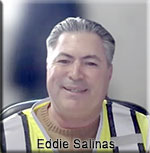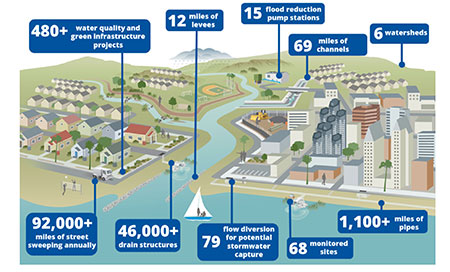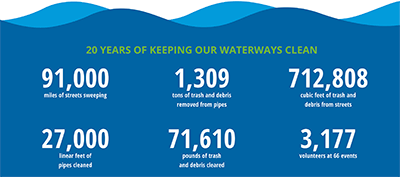San Diego Targets Stormwater Runoff Via Street Sweeping and Dedicated Infrastructure


 Eddie Salinas is the Interim Deputy Director of Operations and Maintenance for the Stormwater Department in the City of San Diego, California. WorldSweeper interviewed him about what San Diego is doing in terms of power sweeping to remove stormwater pollutants.
Eddie Salinas is the Interim Deputy Director of Operations and Maintenance for the Stormwater Department in the City of San Diego, California. WorldSweeper interviewed him about what San Diego is doing in terms of power sweeping to remove stormwater pollutants.
by Ranger Kidwell-Ross, November 2022
As one might imagine for a City that is located on a significant waterway – in this case the Pacific Ocean – the City of San Diego is very proactive in its sweeping program. For one, the City has positioned its sweeping department under the auspices of its Stormwater Department. This is the arrangement that WorldSweeper has long recommended as its editorial perspective.
The goal of the City of San Diego Street Sweeping Program is to sweep 61,000 core miles and pick up around 4,700 tons of trash and debris each year. To do this the City employs 28 sweepers and is increasing its regenerative air machines fleet. That's because the department recognizes the greater pollutant removal ability of regenerative air sweepers in all situations except where the heaviest debris buildup occurs. In those relatively few areas, mechanical broom sweepers must be used.
The City of San Diego is optimizing its program by taking a data-driven approach to make selective changes to its street sweeping program to help maximize the trash and debris removed from neighborhoods and prevent pollution from reaching the ocean.
In 2020 the Stormwater Department was audited ; the audit combined with improved data collection resulted in significant changes to its sweeping program; ultimately making the program more effective. To make sure it was sweeping in the most cost-effective manner possible, the Stormwater Department now employs SAP/Work Manager module software program. This has allowed the Motor Sweeper Operators to record data points to recognize where the greatest volume of debris was located and, at the same time, see where we were sweeping too frequently given the amount of debris buildup in between sweeps at the former schedule.
Salinas said that once they had the information provided by the software platform, sweeping routes in selected areas of the City were modified accordingly based on the data collected from three-years (FY19-21). Some areas with high frequency had very low debris per curb mile while other areas with low frequency had higher debris per curb mile collected. Armed with that information, select routes received increased sweeping frequency while others received reduced frequency to be more effective.
Currently, sweeping schedules vary from route to route (6 times to 130 times per year). The plan is to evaluate and adjust frequencies based on data to be more effective in debris removal. Although most of its sweeping routes use regenerative air sweepers, the software also helped to determine where mechanical broom sweepers were the best choice.
The fact that the City of San Diego has modified its sweeping program significantly as a result of data collection should be a reminder to others street sweeping programs around the country, and the world, that data-driven programs have the potential for designing a better-run operation.
Recognizing that vehicle removal is an important factor in getting sweepers to the curb – but at the same time knowing that parking density and vehicle removal is an issue with residents – the City is conducting an evaluation of four sweeping routes to see what the collection differential shows based upon having vehicles removed. Results will be published at WorldSweeper once they are obtained.
To implement the new parking restrictions, four routes will have new signage posted to implement limited-hour parking restrictions over the next few months. The City will conduct robust outreach in neighborhoods where new signs are posted – including direct mail and informational flyers distributed on parked vehicles – to inform residents of the coming changes. Vehicle citations will begin after a 30-day grace period following the sign installation for areas with new parking restrictions.
In all, 13 routes covering over 300 miles of streets will experience adjustments with the goal of optimizing the efficiency and effectiveness of the street sweeping program and providing more equitable service citywide.
"Street sweeping is one of the most effective tools we have to keep our neighborhoods free of trash and stop pollution from reaching our local waterways and the ocean," said Bethany Bezak, Interim Director of the Stormwater Department. "After analyzing years of data, we identified several opportunities where a slight increase or decrease in the frequency of our street sweeping efforts would significantly bolster the amount of trash and debris collected citywide and improve the overall cleanliness of our City. These changes will help us continue our mission to ensure clean water and clean beaches for all of San Diego."
Although vegetation buildup can be an issue, Salinas cited asbestos from brakes as being a primary pollutant currently targeted for removal before it can run off. Near the beaches, where pollution would be the most serious, catch basins are outfitted with diversion valves that move runoff into the sewer system so it can be treated rather than allowed to enter into waterways.

San Diego recently added a new, smaller, all electric Dulevo sweeper designed to remove debris from narrow roads like bike lanes. Because the City's bike lanes are primarily divided away from car traffic, until now that has been an issue since none of the City's previous sweepers would fit into the smaller pavement width set aside for bicycles. A "Name the Sweeper" contest for the Dulevo is also being conducted to increase the buy-in of City residents on the value of sweeping. This also brings greater recognition that the City is proactive in removing debris in bike lanes.
 Although the City has a number of channels (177) and waterways that feed into the ocean, some of which are concrete and others earthen, the discarding of debris into them, says Salinas, has been a huge issue. The Stormwater Department is budgeted to permit and clean four channels per year, employing dredging and mitigating for environmental impacts in order to increase capacity to the channels. Maintenance of these and all stormwater system infrastructure is very expensive.
Although the City has a number of channels (177) and waterways that feed into the ocean, some of which are concrete and others earthen, the discarding of debris into them, says Salinas, has been a huge issue. The Stormwater Department is budgeted to permit and clean four channels per year, employing dredging and mitigating for environmental impacts in order to increase capacity to the channels. Maintenance of these and all stormwater system infrastructure is very expensive.
This is vitally important since the City of San Diego, like many municipalities, faces a massive challenge ahead as its aging stormwater system currently faces a significant shortfall of $1.4 billion over the next five years. That funding is needed to fund the upgrades necessary to modernize the entire stormwater system. Many San Diegans are unaware of the severity of the problem because much of the equipment and facilities are located underground or out of public view.
 According to its 'Think Blue San Diego' website, "The City's Stormwater Department has been doing all it can with the limited funding currently in place, but it's simply not enough. Several factors have forced the City's stormwater responsibilities to grow over time while funding remains stagnant. Those factors include increasingly strict water-quality requirements, aging and failing infrastructure (which requires costly emergency repairs), a changing climate with more extreme weather, and urbanization."
According to its 'Think Blue San Diego' website, "The City's Stormwater Department has been doing all it can with the limited funding currently in place, but it's simply not enough. Several factors have forced the City's stormwater responsibilities to grow over time while funding remains stagnant. Those factors include increasingly strict water-quality requirements, aging and failing infrastructure (which requires costly emergency repairs), a changing climate with more extreme weather, and urbanization."

That showcases the importance of having the street sweeping and stormwater departments combined as a unified operation. As a result, the City is able to have better decisionmaking in terms of the various pavement-based pollution abatement techniques it should be employing. Without that integration, many public works departments run into budgetary issues that keep them from offering the correct mix of street sweeping and other methods for maximizing runoff pollutant removal.
 The City's commitment to educating its residents about the importance of not allowing stormwater pollution to collect in the first place is central to its Think Blue approach. If you want to know more about the educational resources San Diego provides, which offers a number of recommended steps for both residents and its business community, take a look at its 'Tips & Resources' page. Also offered is a 10-question quiz that allows people to learn more about stormwater pollution prevention.
The City's commitment to educating its residents about the importance of not allowing stormwater pollution to collect in the first place is central to its Think Blue approach. If you want to know more about the educational resources San Diego provides, which offers a number of recommended steps for both residents and its business community, take a look at its 'Tips & Resources' page. Also offered is a 10-question quiz that allows people to learn more about stormwater pollution prevention.
Salinas said that San Diego's stormwater management team recognizes that street sweeping is the "first line of defense" for minimizing pollutant runoff from the 91,000+ miles of roads it sweeps each year. That recognition, combined with its strong education program, has no doubt been a key to the City maintaining its position as one of the most beautiful cities in the United States.
You may reach Eddie Salinas via email sent to ESalinas@
sandiego.gov.

|

